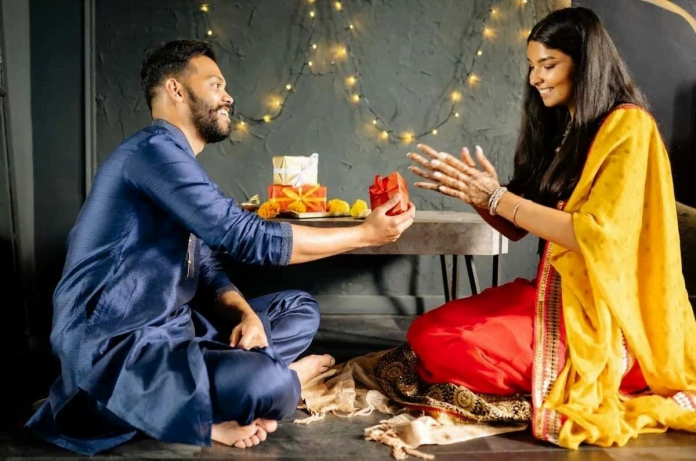Bhai Dooj, also known as Bhaiya Dooj, Bhai Tika, Bhaubeej, Bhai Phonta or Bhratri Dwitiya, is a Hindu festival that celebrates the bond between brothers and sisters every year on Nov 15.
On Bhai Duj, sisters perform aarti (rituals) for their brothers and apply a tilak on their foreheads as a mark of love and protection.
In return, brothers give gifts to their sisters and promise to protect and care for them. A time for family gatherings and strengthening sibling and cousins relationships.
“Unveiling the Significance of Bhai Dooj Celebrations”
In ancient tales, Yamaraj, the god of death, visited his sister Yami, who greeted him by applying a tilak and preparing special dishes. Touched by her love, then Yami wished for his return each year, instructing sisters to perform ceremonies and apply a tilak without fearing death.
Pleased, Yamaraj granted her wish, and this day is now observed as ‘Yama Dwitiya’ in South India. Bhai Dooj falls on November 15 this year, marking the celebration.
Creating Moments of Appreciation
Normally, people gift their sister something she has been wanting or that reflects her interests. Gifts can be considered with personalised touch, such as a handwritten letter expressing your appreciation for her, or a customised item.
Other than gifts one can spend quality time, after performing the ceremony can feed her, take her for a lunch or dinner. As males don’t express their feelings much some gestures like helping her with chores or responsibilities, making some good memories a brother can make his sister special.
A sister can also make her brother special with some heartfelt gifts that aligns with his interests or reflects a shared memory. While, serving him ‘Mithai Thali’, can serve his favourite desserts. If you enjoy cooking, consider preparing a special meal for him. This adds a personal touch and shows effort and thoughtfulness. Also some thoughtful gestures like creating a memory by compiling a photo album or scrapbook with pictures and memories you’ve shared together.
More importantly, supporting his aspirations and goals whether it’s academic, professional, or personal can make him feel more special.
Government Initiatives – for ‘Bhai Dooj’
Indian Railways is actively implementing initiatives this festive season to prioritise traveller comfort while maintaining high-quality service delivery standards. A remarkable 1700 special trains are currently operational throughout India, providing an unprecedented 26 Lakhs berths for passengers—a record-breaking number for this festive period.
Extensive measures for crowd control have been implemented at major railway stations, anticipating large gatherings of travelers heading to diverse destinations for festive celebrations. Government Railway Police and Railway Protection Force personnel are stationed at foot-over bridges to ensure the orderly regulation of crowds, mitigating the risk of stampede-like situations during periods of high congestion.
In a statement, the corporation said, “The DTC will not charged fares from women commuters in both AC and non-AC buses in the Delhi-NCR region on Friday.”
“It has also made sufficient arrangements to manage the rush of passengers on the day. With the initiative of Delhi Government, DTC has decided to allow free travelling of lady commuters in DTC’s city and NCR buses on the occasion of Bhai-Dooj festival on November 9,” it further stated.
Every year on Bhai Dooj, the corporation offers complimentary rides to female passengers. The service is open to women from 8 a.m. to 10 p.m., encompassing both air-conditioned and non-air-conditioned buses.
‘Bhai-Dooj’ celebrations – Then and Now
In 90s, Bhai-Dooj celebrations were marked by traditional rituals, with siblings exchanging heartfelt wishes and applying tikka on brothers foreheads. Families often gathered for special meals, and there was a sense of joy and camaraderie during this festival. The simplicity of those celebrations often included homemade sweets and the exchange of small, thoughtful gifts.
Now-a-days ‘Bhai-Dooj’ celebrations still involve the traditional rituals of applying tikka and exchanging good wishes between siblings. However, contemporary celebrations may include modern elements such as digital communication for those who are geographically separated. Families may opt for a mix of traditional and trendy gifts, and the festive meals might incorporate a blend of traditional and modern dishes. Overall, while the essence of Bhai-Dooj remains, the celebrations may reflect the evolving dynamics of family and technology.
Conveying the celebration
Prajukta, a student of KIIT, Odisha shared with ‘True to Life’, “This is my first year I’m away from home and due to classes I can’t go back to Kolkata, can’t perform ‘Bhai-dooj’. I’m missing those sweet moments we shared together. I’m missing bantering with him. Wish, I could be there today.”
Mr. Arun, a 78 years old shared his old memories with siblings on this day. He said, “Now, people focus more on clicking pictures than focusing on the rituals. In our time, we used to keep fast and I had three sisters. I used to gift all of them as they demanded.”
A newly married wife, Ananya Sahana shared with True to Life, “This is a day we all cousins come and meet together. Spend quality time together, I can’t miss this day. And as this is a celebration of praying for brothers longevity. We all sisters perform it together.”
Bhai-Dooj is a timeless celebration that beautifully captures the essence of sibling bonds. Whether through traditional rituals or modern adaptations, the festival remains a heartfelt occasion, symbolising love, connection, and the enduring strength of family ties.
‘True to Life’ wish you Happy Bhai-dooj.
By: Ankitaa Bal
From Kolkata
Reported for ‘True to Life’
